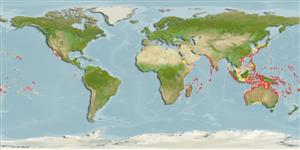Common names from other countries
Environment: milieu / climate zone / depth range / distribution range
Ecología
; rango de profundidad 0 - 50 m (Ref. 96667). Subtropical
Indo-Pacific: except Hawaiian Islands.
Length at first maturity / Tamaño / Peso / Age
Maturity: Lm ? range ? - ? cm
Epizoic, subtidal (Ref. 106854). Inhabits Pocillopora corals (Ref. 106682).
Life cycle and mating behavior
Madurez | Reproducción | Puesta | Huevos | Fecundidad | Larva
Members of the order Decapoda are mostly gonochoric. Mating behavior: Precopulatory courtship ritual is common (through olfactory and tactile cues); usually indirect sperm transfer.
Takeda, M. and R. Webber. 2006. (Ref. 84890)
IUCN Red List Status (Ref. 130435)
CITES status (Ref. 108899)
Not Evaluated
Not Evaluated
Threat to humans
Harmless
Human uses
| FishSource |
Herramientas
Más información
Age/Size
Crecimiento
Length-weight
Length-length
Morfología
Larva
Abundancia
Fuentes de Internet
Estimates based on models
Preferred temperature
(Ref.
115969): 21.7 - 28.8, mean 27.4 (based on 662 cells).
